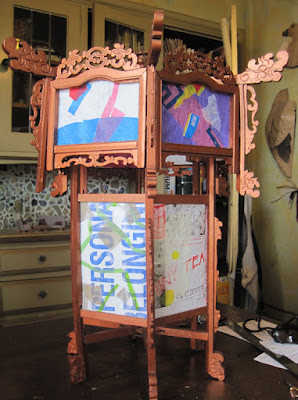 |
| Antique lantern with fused plastic panels |
Welcome back to what is apparently a lifelong project: creative restoration of an antique Chinese lantern. To see and read more about earlier versions of this lantern, see
Chinese Lantern Backstory. To see a range of pieces I've done by ironing recycled plastic bags together, see
Fused Plastic.
Originally pieced together from a crate of broken pieces salvaged from an Asian arts store, the lantern is delicate and a bit rickety. This is the third time since I've owned it that I have had to replace all of the panels. The panels from the last rendition, also fused plastic, had faded from vivid colors to a dull milky white. Below, the repair begins. You can see the old, faded panels still on the lantern.
 |
| Under repair |
The next series of photos offer a revolving view of the latest restoration and the new fused plastic panels.
1. Collect colorful, interesting plastic bags, plastic wrappings, plastic whatever. But save the plain plastic too; you'll need it for your bottom layers.
2. You will need a minimum of four layers of plastic for the panel to have any strength. Throw extra decorations on top.
3. Set iron to fairly high, no steam.
4. Lay out a plain sheet of paper on your work table. Assemble your plastic panel on that sheet of paper. Lay another plain sheet of paper on top. Iron, pressing firmly. How long? I don't know - hum to yourself for a while.
5. When done, peel away the top and bottom layers of plain paper. Sometimes the plastic sticks to the paper. If so, pat it back down and iron a little more. Sometimes the paper sticks to the plastic and tears away. If so, take the plastic to the sink and use water and your fingers to rub away the paper.
And if I am still around in seven years, you will get to see an entirely new rendition of this lantern.






























